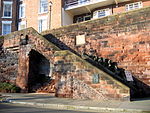St John the Baptist's Church, Chester

St John the Baptist's Church is the former cathedral of Chester, Cheshire, England during the Early Middle Ages. The church, which was first founded in the late 7th Century by the Anglo Saxons, is outside Chester's city walls on a cliff above the north bank of the River Dee. It is now considered to be the best example of 11th–12th century church architecture in Cheshire, and was once the seat of the Bishop of Lichfield from 1075 to 1095. The church remained Chester's cathedral until 1082 when the see was transferred to Coventry. With the dissolution of the monasteries in the 16th century, Chester Abbey became Chester Cathedral and St John the Baptist lost its ecclesiastic importance. The east wing was partially demolished and its status was reduced to a parish church. Although repairs were carried out during the reign of Elizabeth I, the church was garrisoned in the English Civil War by the Roundheads during the siege of Chester in 1645. In the middle to late 19th century, restorations created the present-day church within remains of the larger medieval building. The site is designated Grade I listed building and is recorded in the National Heritage List for England.St John the Baptist remains an active Church of England parish church in the diocese of Chester, the archdeaconry of Chester and the deanery of Chester. Its benefice is combined with that of St Peter, Chester. Historian Alec Clifton-Taylor includes it in his list of 'best' English parish churches.
Excerpt from the Wikipedia article St John the Baptist's Church, Chester (License: CC BY-SA 3.0, Authors, Images).St John the Baptist's Church, Chester
Little Saint John Street, Chester Handbridge
Geographical coordinates (GPS) Address External links Nearby Places Show on map
Geographical coordinates (GPS)
| Latitude | Longitude |
|---|---|
| N 53.189 ° | E -2.8856 ° |
Address
St John the Baptist
Little Saint John Street
CH1 1RF Chester, Handbridge
England, United Kingdom
Open on Google Maps









